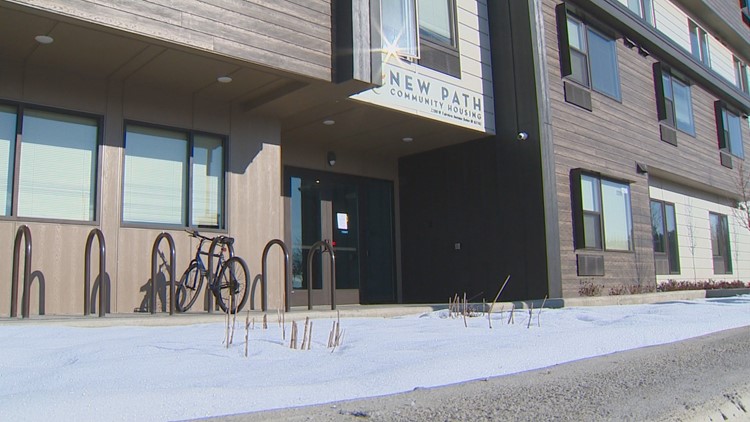BOISE, Idaho — Idaho’s first supportive housing building for the chronically homeless is seeing a success rate higher than the national average, but there are some questions about how to help its residents who require high levels of medical care.
New Path Community Housing opened its doors at the end of 2018 and provided permanent homes for nearly 50 of Boise’s most vulnerable residents experiencing homelessness. Since then, 80% of the residents have been stably housed in the building on Fairview Avenue. Residents also receive social services related to addiction, mental health or any other things impacting their stability.
Despite the success for the majority living at New Path, Interfaith Sanctuary Executive Director Jodi Peterson said she is concerned about a few residents who have intensive health needs leaving New Path and returning to the emergency shelter for her staff to care for. She said in two of the cases, both residents left their homes at New Path and appeared at Interfaith Sanctuary with no warning they were coming.
“I don’t understand how the best option was to move someone who was more sick when they got there back to an emergency shelter that has no ability to do deep care,” Peterson said. “We’re not sterile, we can’t bring in caregivers, so we have so much against us. It seems like the better option would be if you think they’ll end up back with us, bring us in so we can figure out how to do this.”
According to Boise Director of Community Partnerships Wyatt Schroeder, nine people have left New Path since it opened. None of them were legally evicted, and they have either returned to living on the streets or have gone to live with relatives.
New Path is just one piece of the ongoing coalition to address homelessness, called Our Path Home. Schroeder said all of the partners meet regularly to discuss what could be done differently, referrals of different clients between programs or other topics.
The lack of skilled nursing care available for residents of New Path has been a topic of conversation in the past few months, and there is an ongoing effort to find a way to help those with health issues that outpace New Path’s ability to help.
“If we do our job right, New Path won’t be what it looked like when it first opened next year,” he said. “This is meant to be a model that is meant to be flexible. From all of the stories of the nine folks that have exited, we’re learning those lessons, and we’re going to continue to evolve those conversations.”
New Path is a flagship piece of Mayor Dave Bieter administration’s fight against homelessness. It’s based on a nationally recognized model called Housing First, which says once people have a stable place to live, they’ll be better positioned to improve other areas of their lives, rather than asking them to make those other improvements before they’re eligible for housing assistance.
The project is undergoing a six-month evaluation by the Idaho Policy Institute at Boise State University. This report will analyze data to see how New Path has impacted residents, outcomes and other factors and is projected to be completed later this fall.
A similar housing project targeted specifically toward veterans, called Valor Pointe, is set to open on State Street next fall with 27 units.
The construction of Housing First projects to serve the homeless comes amid the Bieter administration asking the U.S. Supreme Court to rule on a 2009 lawsuit from six residents experiencing homelessness, saying the city’s then-policy of prohibiting sleeping outside criminalized homelessness.
Peterson said she understands residents of New Path are working with Terry Reilly Health Services staff to help get them on their feet, but she hoped there would be more communication between their staff and Interfaith Sanctuary’s when a former resident of the shelter is struggling to adjust. Instead, she said, shelter staff is hearing about residents who did not succeed at New Path after they have already left.
“When my child was falling behind in math, they didn’t wait until the end of the school year to tell me — they would give me some tools to keep my son being successful,” she said. “I think that’s what we need, are some progress reports. Our shared histories would make a better foundation for success for these people who are moving from chronic homelessness into their own housing unit.”
Schroeder said there are weekly meetings with all of the partners of Our Path Home to discuss clients and referrals, but Peterson said her staff was still unaware of any issues with the residents who were returning from New Path back to Interfaith Sanctuary.
Ada County Commissioner Diana Lachiondo, who prior to her election at the end of 2018 worked to launch New Path for the city of Boise, said finding a path from the streets to skilled nursing care is difficult.
“We have a dearth of those skilled nursing beds available, and it takes time to get somebody on Medicaid — and this is before it has expanded,” she said. “It’s very rare that we are seeing somebody go straight from living on the streets or in the shelter into a skilled nursing situation.”
This article originally appeared in the Idaho Press, read more on IdahoPress.com.
More from our partner Idaho Press: Middleton mayor's race draws 6 candidates after tumultuous year



